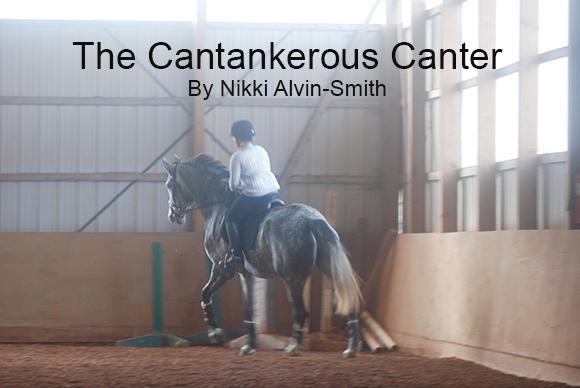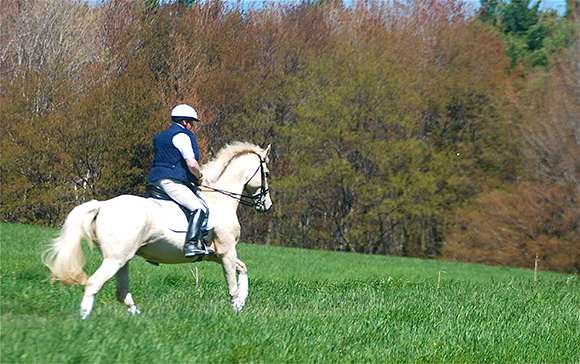The Cantankerous Canter
By Nikki Alvin-Smith

Help! My horse won’t start, stop or stay in the canter.
The three beat canter gait requires good balance. A trot can always be improved, but canter quality is harder to ameliorate.
In general pain is the number one cause of canter issues. It could be back pain, lameness or diseases such as Lyme. Start with a thorough look at your horse’s soundness and saddle fit.
Fix the Upward Transition
Given your horse is healthy and tack properly fitted you begin with work on the longe line. Longeing is the best place to start for both a green and a trained horse that has gone awry because it is easier to encourage your horse to canter from the ground than it is from the saddle. He needs to find his balance without the addition of the rider’s weight or the interference of rider’s aids.
Use side reins that will allow your horse to stretch down in the bridle during the upward transition which you command using your voice aid and the encouragement of the longe whip. Bring the horse slightly in toward you on the longe and make the circle smaller for a few strides. Then release in a forward movement of the longe line and send the horse out on the circle in an outward spiral with the whip being certain to stay behind his girth area. Step smartly toward him as you release the pressure on the line. The release of the pressure on the line will free his inside shoulder to provide the correct lead.
It is imperative that you never reprimand your horse for breaking back to trot or for offering a canter on the longe line or in the saddle when you are at the start of training. Take the canter as a free gift. Stay quietly with the horse in the canter and allow him some freedom in the rein until he comes back to the trot. The important thing is that the horse makes the upward transition on command. Accomplish on request, upward transitions on both reins through several training sessions.
In the Saddle
Utilize the voice command when you ask for the canter and always ask for the transition from a balanced trot. It is prudent to instill the half halt in your horse before working the canter as the horse will then understand the control of the outside rein. If your horse rushes a few steps before making the transition simply bring your horse back with a slow post to the trot. Post slightly behind the movement to slow him down. Do not just pull on the reins. Use half halts on the outside rein.
Be certain that at the moment of canter ask you are not taking pressure on the reins. You must release the inside rein in a forward motion so the inside shoulder can come up and forward to establish the correct lead.
For a horse that still shows reluctance to listen to the command you may need to tap him with a whip behind your outside leg aid to encourage him to strike off. Always use your leg and seat aids before the hand with your goal to keep the contact on the inside rein to a minimum. Think inside leg before inside rein. Try not to grip with your legs in the canter, they should maintain relaxed.
Other Remedies
It can be helpful to have someone ride in front of you on a trained horse and pick up a canter. Your horse will naturally wish to follow. This can also be useful if you have a horse that likes to run and panics in the canter. The rider in front can bring their horse back to the trot and most likely your horse will listen to your aids enough to follow.
For a horse that likes to run through the rein in the upward transition it is best to ask for the canter as you approach the short side of the arena. For horses that like to run off in the canter you can also work the horse on a generous circle as circles will give you more control and always leave room to the outside of the circle.
The Importance of Space
Be certain that you have enough space for the horse to canter. A tiny ring will make the process much harder for your horse as it requires more balance. The long sides of the arena and large circles are the best places to start. If your ring space is confined and your horse is quiet on the trail and you have someone to ride out with you can also ask for a canter up slight inclines. A lead horse can take the canter and your horse will follow. The incline will give you more control of the horse and he will learn to push from behind to balance himself.

Improve the Quality of the Canter
The quality of the canter itself cannot be improved in the canter. A good quality canter comes from a horse that is supple and well balanced. This is achieved by schooling lateral work in the walk and trot. Work your horse in shoulder fore, shoulder in, haunches in and then half pass. I then add haunches out. I do not like to add haunches out before the half pass is established as I do not want the horse to avoid straightness or become late behind in his half pass. Always begin training these exercises in the walk before the trot to give the horse time to figure out what you are asking him to do.
Problem Solving
If your horse has difficulty staying in the canter rushing him off his feet will not help. Go back to working more on the longe line and under saddle work suppling exercises at the trot to improve the horse’s balance and when in the canter use more inside leg and do not hold on to the inside rein. A right-handed rider will always tend to hold the left rein and vice-versa.
If you try all of the above and still have difficulty you must look to yourself as a rider. Check you are applying aids to canter correctly and work on developing your own independent seat. Don’t be shy to ask for help from a professional trainer.
About the author: Nikki Alvin-Smith is an international Grand Prix dressage trainer/clinician who has competed in Europe at the Grand Prix level earning scores of over 72%. Together with her husband Paul, who is also a Grand Prix rider, they operate a private horse breeding/training farm in Stamford, NY.


